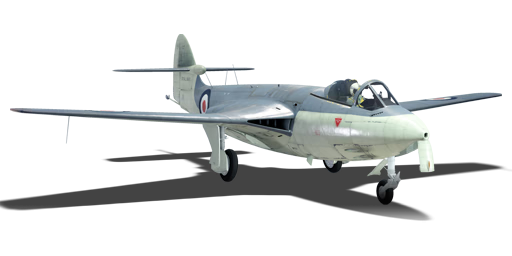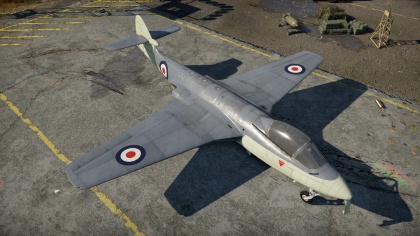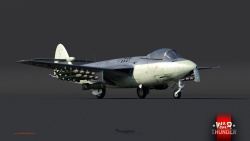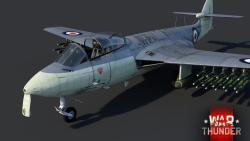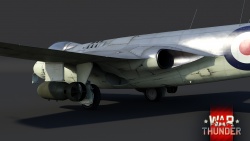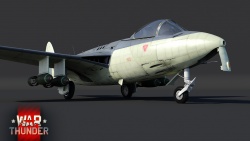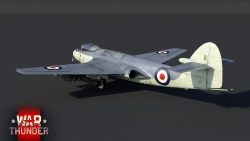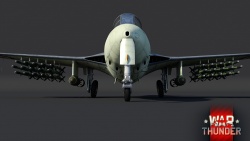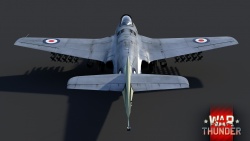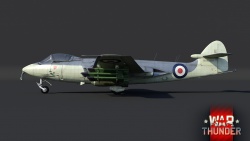Difference between revisions of "Sea Hawk FGA.6"
(Edits) |
m (Not having air to air missiles isnt really a con when pretty much no aircraft at 7.7-8.3 come with them.) (Tag: Visual edit) |
||
| Line 90: | Line 90: | ||
|- | |- | ||
! colspan="3" | Engine characteristics | ! colspan="3" | Engine characteristics | ||
| − | ! colspan="4" | Mass with fuel (no weapons load) || rowspan="2" | Max Takeoff<br/>Weight | + | ! colspan="4" | Mass with fuel (no weapons load) || rowspan="2" | Max Takeoff<br />Weight |
|- | |- | ||
! Weight (each) || colspan="2" | Type | ! Weight (each) || colspan="2" | Type | ||
| Line 107: | Line 107: | ||
| 0.49 || 0.45 || 0.41 || 0.40 || 0.33 | | 0.49 || 0.45 || 0.41 || 0.40 || 0.33 | ||
|- | |- | ||
| − | | ''Optimal'' || 2,376 kgf<br/>(0 km/h) || N/A | + | | ''Optimal'' || 2,376 kgf<br />(0 km/h) || N/A |
| 0.49 || 0.45 || 0.41 || 0.40 || 0.33 | | 0.49 || 0.45 || 0.41 || 0.40 || 0.33 | ||
|- | |- | ||
| Line 211: | Line 211: | ||
* No combat flaps | * No combat flaps | ||
| − | |||
* Slow acceleration | * Slow acceleration | ||
* Although takeoff flaps can be used at near any speed and can offer a decent manoeuvrability boost, you bleed speed quickly when they are deployed | * Although takeoff flaps can be used at near any speed and can offer a decent manoeuvrability boost, you bleed speed quickly when they are deployed | ||
| Line 235: | Line 234: | ||
== Media == | == Media == | ||
<!-- ''Excellent additions to the article would be video guides, screenshots from the game, and photos.'' --> | <!-- ''Excellent additions to the article would be video guides, screenshots from the game, and photos.'' --> | ||
| + | |||
;Images | ;Images | ||
<div><ul> | <div><ul> | ||
| Line 253: | Line 253: | ||
;Related Development | ;Related Development | ||
| + | |||
* [[Sea Hawk Mk.100]] (premium version in German tree) | * [[Sea Hawk Mk.100]] (premium version in German tree) | ||
;Contemporary Aircraft | ;Contemporary Aircraft | ||
| + | |||
* de Havilland [[Vampire FB 5]] | * de Havilland [[Vampire FB 5]] | ||
* [[F-84B-26|F-84]] Thunderjet | * [[F-84B-26|F-84]] Thunderjet | ||
| Line 270: | Line 272: | ||
* ''encyclopedia page on the aircraft;'' | * ''encyclopedia page on the aircraft;'' | ||
* ''other literature.'' --> | * ''other literature.'' --> | ||
| + | |||
* [[wt:en/news/6039-development-sea-hawk-fga-6-jet-vulture-en|[Devblog] Sea Hawk FGA.6: Jet Vulture]] | * [[wt:en/news/6039-development-sea-hawk-fga-6-jet-vulture-en|[Devblog] Sea Hawk FGA.6: Jet Vulture]] | ||
{{AirManufacturer Hawker}} | {{AirManufacturer Hawker}} | ||
{{Britain jet aircraft}} | {{Britain jet aircraft}} | ||
Revision as of 02:04, 20 December 2020
Contents
| This page is about the British jet fighter Sea Hawk FGA.6. For German premium version, see Sea Hawk Mk.100. |
Description
The Sea Hawk FGA.6 is a rank V British jet fighter
with a battle rating of 8.0 (AB/RB) and 7.3 (SB). It was introduced in Update 1.87 "Locked On".
At the tail end of World War II, Hawker Aircraft's design team was working on the way to utilize new jet engine technology. Hawker utilized a modified Sea Fury who would be the basis for their new jet aircraft. Adapting the plane to the new Rolly-Royce Nene turbojet engine required substantial reworking of the aircraft fuselage. Initially, the British Air Ministry showed little interest in the aircraft. Thus later Hawker pitched the idea of the plane to the navy, which was not overly enthused about the project, though ultimately accepted three prototypes due to the long-range potential of these aircraft.
Orders for the Hawker Sea Hawk came about; however, due to its careful designs, it was quickly superseded by other British fighters in development with more advanced features. In 1956 production was terminated and the aircraft was put up for an evaluation to the export market. Though Australia and Canada tested out the plane, they instead opted for American fighters. Other nations such as Germany, the Netherlands and India incorporated the Sea Hawk into their navies. Eventually, they saw action in the Suez Crisis and the Indo-Pakistani Wars of 1965 and 1971. India was able to sink over a dozen Pakistani ships without a single Sea Hawk loss.
The Sea Hawk though classified as a fighter, it is primarily a ground-pounding aircraft. With an assortment of bombs and rockets in conjunction with its four 20 mm autocannons, this aircraft can make short work of structures and vehicles on the ground. One benefit of this aircraft compared to others is the ability to mix and match your ordinance depending on the task at hand. The pilot can choose from all bombs, all rockets (two different types) or a mix of both. As noted, the Sea Hawk weapon's configuration outfits four 20 mm autocannons. These guns are arranged for optimal use against the ground and air targets, in fact, they are the only weapons on this aircraft which can be effectively used in air-to-air battles.
Though the Sea Hawk development did not configure this aircraft to be an interceptor like many of its swept-wing contemporaries, it can none the less be a worthy adversary that can seem to pull off the impossible. With straight wings and a slower top speed, this fighter is a bit more manoeuvrable than many of the Mach-plus fighters it will face. Careful usage of the flaps, air brakes and manoeuvring can cause faster aircraft to overshoot leaving their tail-ends vulnerable to being chewed off by the Sea Hawk's four 20 mm autocannons. Sea Hawks should not be counted off as an easy target, in the hands of a capable pilot, they can quickly get behind you and open fire!
General info
Flight performance
| Characteristics | Max Speed (km/h at 0 m - sea level) |
Max altitude (metres) |
Turn time (seconds) |
Rate of climb (metres/second) |
Take-off run (metres) | |||
|---|---|---|---|---|---|---|---|---|
| AB | RB | AB | RB | AB | RB | |||
| Stock | 919 | 898 | 13500 | 27.0 | 27.8 | 25.9 | 24.4 | 650 |
| Upgraded | 943 | 933 | 25.4 | 26.0 | 38.8 | 32.0 | ||
Details
| Features | |||||
|---|---|---|---|---|---|
| Combat flaps | Take-off flaps | Landing flaps | Air brakes | Arrestor gear | Drogue chute |
| X | ✓ | ✓ | ✓ | ✓ | X |
| Limits | ||||||
|---|---|---|---|---|---|---|
| Wings (km/h) | Gear (km/h) | Flaps (km/h) | Max Static G | |||
| Combat | Take-off | Landing | + | - | ||
| 1012 | 370 | N/A | 850 | 796 | ~11 | ~6 |
| Optimal velocities (km/h) | |||
|---|---|---|---|
| Ailerons | Rudder | Elevators | Radiator |
| < 461 | < 600 | < 550 | N/A |
Engine performance
| Engine | Aircraft mass | ||||||
|---|---|---|---|---|---|---|---|
| Engine name | Number | Empty mass | Wing loading (full fuel) | ||||
| Rolls-Royce Nene-Mk.103 | 1 | 4,450 kg | 232 kg/m2 | ||||
| Engine characteristics | Mass with fuel (no weapons load) | Max Takeoff Weight | |||||
| Weight (each) | Type | 10m fuel | 20m fuel | 30m fuel | 35m fuel | ||
| 1,000 kg | Centrifugal-flow turbojet | 4,866 kg | 5,278 kg | 5,789 kg | 5,995 kg | 7,170 kg | |
| Maximum engine thrust @ 0 m (RB / SB) | Thrust to weight ratio @ 0 m (100%) | ||||||
| Condition | 100% | WEP | 10m fuel | 20m fuel | 30m fuel | 35m fuel | MTOW |
| Stationary | 2,376 kgf | N/A | 0.49 | 0.45 | 0.41 | 0.40 | 0.33 |
| Optimal | 2,376 kgf (0 km/h) |
N/A | 0.49 | 0.45 | 0.41 | 0.40 | 0.33 |
Survivability and armour
- 64 mm bulletproof glass - Armoured windscreen
- All fuel tanks and engine in the middle of the fuselage
Armaments
Offensive armament
The Sea Hawk FGA.6 is armed with:
- 4 x 20 mm Hispano Mk.V cannons, chin-mounted (150 rpg = 600 total)
Suspended armament
The Sea Hawk FGA.6 can be outfitted with the following ordnance:
- Without load
- 2 x 500 lb G.P. Mk.IV bombs (1,000 lb total)
- 4 x 500 lb G.P. Mk.IV bombs (2,000 lb total)
- 2 x 1,000 lb M.C. 1,000 lb Mk.I bombs (2,000 lb total)
- 30 x AP Mk II rockets
- 16 x RP-3 rockets
- 2 x 500 lb G.P. Mk.IV bombs + 10 x AP Mk II rockets (1,000 lb total)
- 2 x 500 lb G.P. Mk.IV bombs + 30 x AP Mk II rockets (1,000 lb total)
- 2 x 500 lb G.P. Mk.IV bombs + 16 x RP-3 rockets (1,000 lb total)
Usage in battles
In air realistic battles, you have a good top speed with okay acceleration and a decent climb rate (particularly when fully upgraded). After takeoff, build speed to about 500 kph then enter a 10 degree climb (a 10 degree climb straight off the runway can also work in some situations). You can either continue climbing to high altitude (~5 km) to engage high flying bombers /fighters and gain an altitude advantage; or you can choose to level off at 3-4 km and focus on building speed to engage enemy fighters and bombers at lower altitudes (aircraft such as Ar 234 C-3s and IL-28s will often fly low to get to bases / ground targets quickly) depending on your preferred play-style.
When engaging enemy aircraft, use your good speed and excellent energy retention to your advantage; do not bleed speed to keep on a slower enemy's tail; swoop in fire off a burst of rounds and then break contact and come around for another pass. The Sea Hawk has good manoeuvrability for a jet aircraft (although it is not in the same league as the Vampire and Ho 229), and your energy retention does make limited turning engagements with less manoeuvrable targets a valid option in some situation, although you will bleed too much speed to justify prolonged turn fights. You can safely deploys flaps at any speed below 850 kph and they can significantly increase turning ability, however they create a lot of drag (you will not hold 600 kph in level flight with them deployed) so should be used sparingly. A good tactic is to deploy the flaps as you enter or are in mid-turn to help kick the plane around and then undeploy them as soon as possible afterwards. Do not get complacent with the flaps, although you can use them at most speeds. The Sea Hawk can exceed 900 kph so you may be in for a nasty surprise if you deploy them a full speed.
It is also worth remembering that the Sea Hawk is a naval aircraft, unlocking the ability to use aircraft carriers for takeoff and landing. A carrier spawn can sometimes be desirable, be it for putting you further away / closer to the enemy (more climbing time or quicker action), or giving you the chance to attack from an area of the map the enemy team are not expecting. Likewise if you need to rearm and suspect the enemy are waiting for you at the airfield, you can always divert to a carrier.
Modules
| Tier | Flight performance | Survivability | Weaponry | |||
|---|---|---|---|---|---|---|
| I | Fuselage repair | Offensive 20 mm | ||||
| II | New boosters | Compressor | Airframe | 2 500 LB GP | 25 lb A.P. Mark II | |
| III | Wings repair | Engine | New 20 mm cannons | 4 500 LB GP | 60 lb S.A.P. Mark I | |
| IV | G-suit | Cover | 1000 LB GP | |||
If you are looking to play in air battles, then go for all flight performance upgrades first (or 20 mm belts if you can't stand the stock belts). For ground battles, consider mixing in some suspended armament options as well. It is worth noting that by itself the 25 lb A.P. Mark I option is useless as all load-outs using the rockets also equip bombs, so it cannot be used until the two 500 LB GP load-out is researched (by contrast the bombs can be equipped without researching the rockets).
Pros and cons
Pros:
- Extremely high flap breakage speed (850 km/h for takeoff, 796 km/h for landing)
- Good selection of suspended armament options
- Favorable matchmaking in Air Realistic battles with the only up-tier threats being the (F9Fs and G.91 pre-serie)
- Reasonably quick
- Good manoeuvrability (not as good as Vampire though)
- Very good energy retention
- Decent at climbing
- High maximum G loading, hard to rip the wings off
Cons:
- No combat flaps
- Slow acceleration
- Although takeoff flaps can be used at near any speed and can offer a decent manoeuvrability boost, you bleed speed quickly when they are deployed
- Flaps also double as air brakes, if flaps are deployed you need to wait for them to fully retract before you can use air brakes
History
Already by the end of WW2, Hawker began working on their first jet-propelled aircraft as the new jet propulsion technology became available. As a basis for their new aircraft, they took the Hawker Fury and began adapting it to house a turbojet engine. The project received the designation P.1035.
As work went on, the attention the project garnered initially from the Air Ministry and the Admiralty was rather low and eventually dropped completely, forcing Hawker to continue development of the aircraft under a private venture. During the development process, the initial design of the aircraft underwent significant changes and the resulting version was designated as P.1040.
However, as Hawker's aircraft offered a good range, the Navy ordered three prototypes to be built in May 1946 and subsequently put through evaluation. Testing and tweaking of the design continued throughout the late 1940s until the first production orders for the aircraft, dubbed Sea Hawk, were received in November 1949.
The first Sea Hawks entered service with the FAA in 1953, with the remaining over 500 machines entering service by the mid-1950s. The Sea Hawk's service life is primarily marked by their extensive use during the Suez Crisis in the late 1950s, where they successfully proved themselves.
As one of the last modifications of the type, the Sea Hawk FGA.6 was developed to incorporate changes from the previous FB.3 and FGA.4 ground attack variants and combine them with the new Rolls-Royce Nene Mk.103 engine which provided a greater power output.
In the early 1960s, the British Navy almost completely abandoned the use of Sea Hawk and a handful of other vehicles being used in a limited number of secondary roles until the end of the decade. However, the aircraft was still in service by some countries like West Germany, the Netherlands and India. In fact, India continued to operate Sea Hawks well into the 1980s!
- From Devblog
Media
- Images
See also
- Related Development
- Sea Hawk Mk.100 (premium version in German tree)
- Contemporary Aircraft
- de Havilland Vampire FB 5
- F-84 Thunderjet
- F2H Banshee
- Gloster Meteor
- MiG-15
- MiG-17
- Supermarine Attacker FB 1
- Dassault M.D.450B Ouragan
External links
| Hawker Aircraft Limited | |
|---|---|
| Biplane fighters | |
| Fury | Fury Mk I · Fury Mk II |
| Nimrod | Nimrod Mk I · Nimrod Mk II |
| Scout plane | Osprey Mk IV |
| Piston fighters | |
| Hurricane | Hurricane Mk I/L · Hurricane Mk.I/L FAA M · Sea Hurricane Mk IB · Sea Hurricane Mk IC · Hurricane Mk IIB/Trop · Hurricane Mk IV |
| Typhoon | Typhoon Mk Ia · Typhoon Mk Ib · Typhoon Mk Ib/L |
| Tempest | Tempest Mk V · Tempest Mk V (Vickers P) · Tempest Mk II |
| Fury | Sea Fury FB 11 |
| Jet fighters | |
| Hunter | Hunter F.1 · Hunter F.6 · Hunter FGA.9 |
| Sea Hawk | Sea Hawk FGA.6 |
| Harrier | Harrier GR.1 · Harrier GR.3 |
| Export | ▄Hurricane Mk I/L · ▂Hurricane Mk IIB · ◘Sea Fury FB 51 |
| ◘Sea Hawk Mk.50 · ◄Sea Hawk Mk.100 · ◘Hunter F.6 · ◌Hunter F.58 · J34 · AV-8A · AV-8C · ▄AV-8S | |
| Captured | ▀Tempest Mk V |
| See Also | Fokker |
| Britain jet aircraft | |
|---|---|
| Blackburn | Buccaneer S.1 · Buccaneer S.2 · Buccaneer S.2B |
| British Aerospace | Harrier GR.7 · Sea Harrier FRS.1 (e) · Sea Harrier FRS.1 · Sea Harrier FA 2 |
| British Aircraft Corporation | Strikemaster Mk.88 |
| English Electric | Canberra B Mk 2 · Canberra B (I) Mk 6 · Lightning F.6 · Lightning F.53 |
| Gloster | Meteor F Mk 3 · Sea Meteor F Mk 3 · Meteor F Mk 4 G.41F · Meteor F Mk 4 G.41G · Meteor F Mk 8 G.41K · Meteor F Mk.8 Reaper |
| Javelin F.(A.W.) Mk.9 | |
| de Havilland | Vampire F.B.5 · Venom FB.4 · Sea Venom FAW 20 · Sea Vixen F.A.W. Mk.2 |
| Hawker | Sea Hawk FGA.6 · Hunter F.1 · Hunter F.6 · Hunter FGA.9 · Harrier GR.1 · Harrier GR.3 |
| Panavia | Tornado GR.1 · Tornado GR.4 · Tornado F.3 · Tornado F.3 Late |
| SEPECAT | Jaguar GR.1 · Jaguar GR.1A · Jaguar IS |
| Supermarine | Attacker FB 1 · Attacker FB.2 · Scimitar F Mk.1 · Swift F.1 · Swift F.7 |
| Foreign | Phantom FG.1 (USA) · Phantom FGR.2 (USA) · F-4J(UK) Phantom II (USA) |
| Australia | F-111C |
| India | ▄MiG-21 Bison |
| South Africa | ▄JAS39C |


